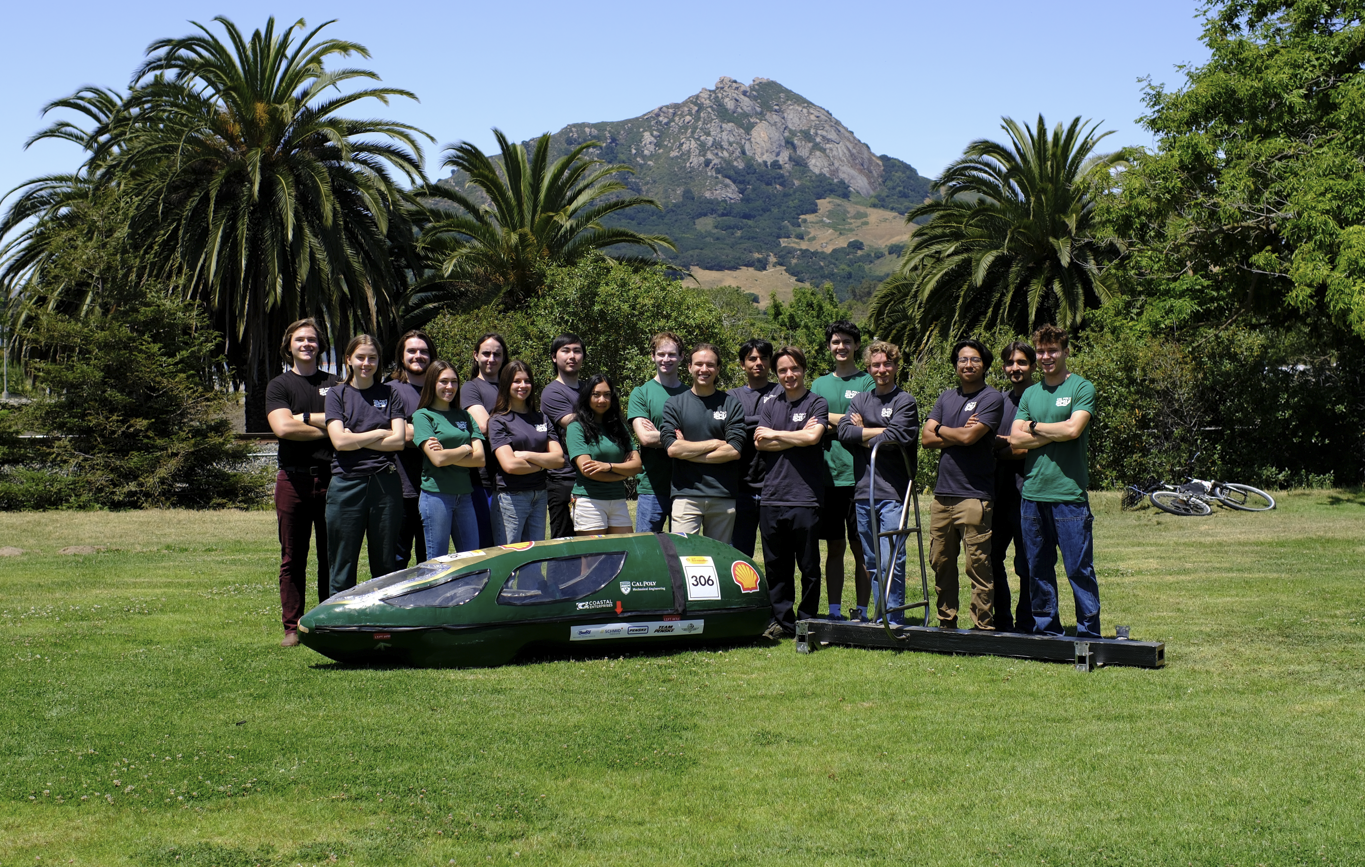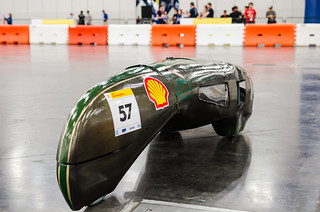Team History
2024 - 2025 Team - E-Ventus III, Urban Concept Design

2023 -2024 Team - E-Ventus III, Urban Concept Design
2022 -2023 Team - E-Ventus II
2021 - 2022 Team - E-Ventus
During the COVID-19 pandemic, Cal Poly Supermileage didn’t have enough team members to survive. Our team was re-founded in 2021, and has been thriving ever since.
2007 – Black Widow – 1902 MPG – 1st Place
After competing for many years in SAE’s Supermileage race, in 2006 the Cal Poly team decided to switch focus to the more innovative (and competitive) Shell Eco-Marathon competition. Work on the school’s very first entry into the race, affectionately named “Black Widow,” began early in 2006, and was designed to compete in the Prototype – Gasoline class. Utilizing a carbon-fiber monocoque chassis design and a 50cc Honda GX50 engine, Black Widow was far more technologically advanced than any previous Cal Poly Supermileage vehicle. The project culminated with a 1st place finish at the 2007 Eco-Marathon Competition (out of approximately 50 teams), where the vehicle achieved 1902 MPG.
2008 – Black Widow – 2752 MPG – 2nd Place
 Cal Poly brought Black Widow back to the 2008 competition, this time with a number of improvements, including programmable Megasquirt EFI, significantly lower rolling resistance, and improved steering geometry. All these upgrades contributed to a phenomenal result of 2752.2 MPG, which remains standing as Cal Poly’s all-time record. Unfortunately, other teams had been furiously innovating as well, and Mater Dei High School barely beat out Cal Poly’s score, leaving the team to settle for a lose second finish.
Cal Poly brought Black Widow back to the 2008 competition, this time with a number of improvements, including programmable Megasquirt EFI, significantly lower rolling resistance, and improved steering geometry. All these upgrades contributed to a phenomenal result of 2752.2 MPG, which remains standing as Cal Poly’s all-time record. Unfortunately, other teams had been furiously innovating as well, and Mater Dei High School barely beat out Cal Poly’s score, leaving the team to settle for a lose second finish.
2009 – Black Widow – 2358 MPG – 2nd place
 Once again competing with Black Widow, the team made relatively few significant changes to the vehicle itself, placing more emphasis on driver technique and R&D projects. Unfortunately, this time the team was not able to replicate the incredible results of the previous year, however they still managed to achieve 2nd place again with 2358 MPG.
Once again competing with Black Widow, the team made relatively few significant changes to the vehicle itself, placing more emphasis on driver technique and R&D projects. Unfortunately, this time the team was not able to replicate the incredible results of the previous year, however they still managed to achieve 2nd place again with 2358 MPG.
2010 – Black Widow – 1324 MPG – 10th place
Black Widow’s last competition, the 2010 race yielded relatively disappointing results. The competition location was moved from California Speedway in Fontana, CA (a high-speed dedicated racetrack) to closed public roads in Houston, Texas, a much rougher and more unforgiving surface. The team struggled to cope with these new race conditions, and after a number of mechanical failures, finished in 10th place with 1325 MPG.
2012 – Lamina I – 1400 MPG – 3rd place
 After a one-year hiatus from the Prototype division, Cal Poly returned in full force to the 2012 competition with a brand new vehicle, named Lamina. With very aggressive design targets regarding vehicle weight and drag, the Lamina chassis was revolutionary. Weighing in at just 12lbs, the bare chassis was one of the lightest ever seen at the race. Due to the space requirements of such a small vehicle, the decision was made to continue using the compact, simple, and commonly-used Honda GX50 engine.
After a one-year hiatus from the Prototype division, Cal Poly returned in full force to the 2012 competition with a brand new vehicle, named Lamina. With very aggressive design targets regarding vehicle weight and drag, the Lamina chassis was revolutionary. Weighing in at just 12lbs, the bare chassis was one of the lightest ever seen at the race. Due to the space requirements of such a small vehicle, the decision was made to continue using the compact, simple, and commonly-used Honda GX50 engine.
2013 – Lamina II – 1180 MPG – 7th place
 With the large weight advantage of the Lamina design, a second iteration of the car was created, this time using a resin-infusion carbon fiber manufacturing method. The advanced design and manufacturing of the monocoque chassis earned the team Shell’s prestigious Design Award, however fuel mileage results did not meet the team’s expectation. Cal Poly’s score of 1180 MPG was good for 7th place.
With the large weight advantage of the Lamina design, a second iteration of the car was created, this time using a resin-infusion carbon fiber manufacturing method. The advanced design and manufacturing of the monocoque chassis earned the team Shell’s prestigious Design Award, however fuel mileage results did not meet the team’s expectation. Cal Poly’s score of 1180 MPG was good for 7th place.
2014 – Lamina III – 1384 MPG – 6th place

For 2014, a relatively young and inexperienced team decided to give the Lamina design one more shot. A third iteration of the chassis was created, but the big change came from the engine team, where the team’s options were re-evaluated. Significant research was performed on Yamaha’s XF50 engine used in certain small-displacement scooter lines, and it was thoroughly compared to the well-known Honda. Unlike the small and simple Honda used by Cal Poly’s past vehicles, as well as the vast majority of competitors, the Yamaha was a modern and high-tech engine designed for fuel efficiency from the factory. After installing a programmable EFI system, and fitting the new engine into the chassis (with some difficulty), the car was ready for competition. The team won 6th place with 1384 MPG, a score that revealed the large potential of the new Yamaha engine.
2015 – Ventus I – 988 MPG – 7th place
 Following the 2014 competition, the general team consensus was that the limits of the Lamina design had been reached. The large compromises in reliability, manufacturability, and drivability made in the quest for weight savings were starting to become very apparent, and very limiting. Additionally, the Yamaha XF50 engine, which through preliminary dyno testing was proving itself to be inherently more efficient than the old Honda, had been almost impossible to fit in the Lamina body. It was once again time for a new, clean-slate design, one that was built for the Yamaha engine, and engineered to be all-around more competitive. Thus the Ventus was born. Besides an engine compartment designed to house the hefty Yamaha and all the supporting subsystems, key design targets included increased visibility, higher torsional rigidity, and dimensions suitable for the school autoclave (in order to manufacture the body out of pre-preg carbon fiber). All of these targets were met, and the result was a chassis that still weighed in at only 16 pounds, very much in league with Cal Poly’s top competitors.
Following the 2014 competition, the general team consensus was that the limits of the Lamina design had been reached. The large compromises in reliability, manufacturability, and drivability made in the quest for weight savings were starting to become very apparent, and very limiting. Additionally, the Yamaha XF50 engine, which through preliminary dyno testing was proving itself to be inherently more efficient than the old Honda, had been almost impossible to fit in the Lamina body. It was once again time for a new, clean-slate design, one that was built for the Yamaha engine, and engineered to be all-around more competitive. Thus the Ventus was born. Besides an engine compartment designed to house the hefty Yamaha and all the supporting subsystems, key design targets included increased visibility, higher torsional rigidity, and dimensions suitable for the school autoclave (in order to manufacture the body out of pre-preg carbon fiber). All of these targets were met, and the result was a chassis that still weighed in at only 16 pounds, very much in league with Cal Poly’s top competitors.
Unfortunately, the thorough design and manufacturing of the chassis took almost the entire year to complete, and left very little time for subsystem development and vehicle testing. As the 2015 competition began, the engine and chassis performed spectacularly, but the team was plagued by a host of drivetrain difficulties that, in the end, only allowed the completion of one full run. This run yielded 988 MPG, earning Cal Poly 7th place overall.
2016 – Ventus II – 1215 MPG - 3rd Place

2017 - Ventus II - 1500.7 MPG - 4th Place In ICE
 The team was able to reuse the previous year's chassis and instead focus on driving technique and redesigning the steering systems. Drive train was improved and the team was able to complete a significant amount of testing. The drivers received lots of practice before competing in Detroit, Michigan.
The team was able to reuse the previous year's chassis and instead focus on driving technique and redesigning the steering systems. Drive train was improved and the team was able to complete a significant amount of testing. The drivers received lots of practice before competing in Detroit, Michigan.
2018 - Delamina - 1297 MPG - 4th Place In ICE
 The team created a brand new chassis this year and focused on a new design for each subsystem. The engine was brought over from the previous car, but the drive train was majorly updated as part of graduating students' senior project. The focus was on manufacturing this year, with the drivers getting the chance to practice their technique a month before competition. Our main driver was the back up driver from the previous year, so she had experience under her belt to prep her for competition in Sonoma Valley.
The team created a brand new chassis this year and focused on a new design for each subsystem. The engine was brought over from the previous car, but the drive train was majorly updated as part of graduating students' senior project. The focus was on manufacturing this year, with the drivers getting the chance to practice their technique a month before competition. Our main driver was the back up driver from the previous year, so she had experience under her belt to prep her for competition in Sonoma Valley.
2019 - Delamina - 585 MPG - 15th Place in ICE
 The team was able to reuse the previous year's chassis and instead focus on driving technique and redesigning the steering systems. Drive train was improved with the use of a new Engines Lab. This year we debuted a new driver who powered through the rainy conditions. Even after rolling on the wet track, she fearlessly continued on Sonoma Raceway.
The team was able to reuse the previous year's chassis and instead focus on driving technique and redesigning the steering systems. Drive train was improved with the use of a new Engines Lab. This year we debuted a new driver who powered through the rainy conditions. Even after rolling on the wet track, she fearlessly continued on Sonoma Raceway.